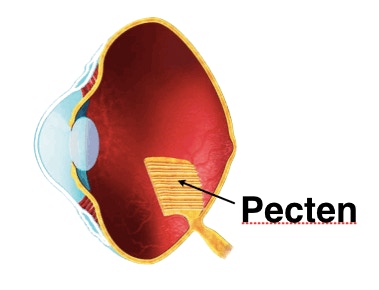Portal, AZ - Rodeo, NM
Serving The Communities Of Portal and Rodeo (www.portal-rodeo.com)
Serving The Communities Of Portal and Rodeo (www.portal-rodeo.com)

Birding News & Views

The Eyes Have It
Pecten: A Unique Structure In The Eyes Of Birds
by Howard Topoff
How much energy does it take to see? The visual system is one of the most energetically demanding systems in the brain. Although seeing obviously doesn't require the energy of running a marathon, the millions of rods and cones in the retina use quite a bit of oxygen and nutrients to convert light into nerve impulses and transmit them to the brain. So you will not be surprised that the human retina (and that of most animals) is infiltrated with a large supply of blood vessels. After all, it's the blood that carries oxygen and nutrients to all retinal cells. But all these blood vessels create their own problem: they block some of the light from reaching the retina.
Birds, which are even more visually dominant than humans, have solved this problem in a most unusual way. The retinas in their eyes contain NO blood vessels - they are avascular. So, the $64.00 question is: how do the eyes of birds, which are among the best developed in the animal world, function without these vital molecular supplies? The answer is their retinas ARE supplied with oxygen, amino acids, sugars, and all necessary nutrients, but not from blood vessels in the retina. Instead, birds have evolved a truly unique structure called the PECTEN.
The Pecten (see diagram) consists of folded tissue and is filled with melanin granules ( the same pigment that darkens our skin and hair - well, it used to darken MY hair). It projects from the retina into the vitreous, is well supplied with blood vessels and keeps the retina supplied with oxygen and nutrients.
Scientists still have a lot to learn about this mysterious structure and have hypothesized several additional interesting functions. For example:
1. Slight warming of pecten due to absorption of light by melanin granules enhances the secretion of nutrients into the vitreous, eventually to be absorbed by the bird's avascular retina.
2. The pecten may shade the retina from dazzling light or aid in detecting moving objects. And since it contains melanin, it may lessen stray light entering the bird eye to reduce background glare.
3. You probably heard of the blood-brain barrier. The cells of the capillaries in the brain are so tightly joined that many (especially toxic) substances are prevented from diffusing into brain cells. Turns out the capillaries in the pecten also have these "tight junctions," so the pecten might constitute a blood-retina barrier, keeping harmful substances out of the bird's retina.
When it comes to relative size, visual acuity, and spectral sensitivity, the eyes of birds are truly unique. The evolution of the PECTEN is just one additional adaptation that gives new meaning to the term "Bird Brain.”
_________________________________________________________________
_________________________________________________________________

Willow Tank - Helping A Critical Wildlife Sanctuary
by Alan Craig
It is critical to keep water in Willow Tank to provide wildlife habitat. One would have to camp out at the tank to fully appreciate how many birds, bats and critters use the water at WT, let alone the food and cover the vegetation provides. During the 2+ months of Spring migration and a much longer period during Fall migration, those birds that migrate by day may stop only briefly for a drink or to grab a few insects before continuing out of sight en route to their nesting or wintering grounds.
It is owned by the Larry River's family and we owe a big thank you to them for their extensive financial and physical help in keeping this vital water source open.
Willow Tank is open to bird watchers. There is water only in the deep end now as the banks and reinforcing is completed. There will be multiple viewing stations and stairs, which will be completed in the next month or so, followed by the refilling.
A few days ago there were 4 White-faced Ibis feeding on the pond along with a pair of Mexican Ducks.
Check it out!
WT is on Sulphur Canyon Rd. west off of Stateline Road just as Stateline intersects U.S. 80.
Friends of Cave Creek Canyon strongly believes in preserving and improving this valuable resource. We have made a sizeable donation and encourage you to also help. For more information, contact Alan Craig at 520-558-2220 or acraig@me.com
